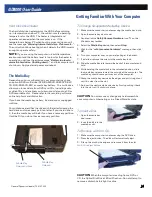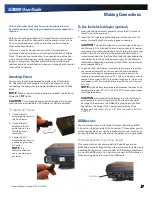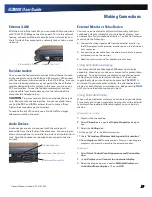
General Dynamics Itronix | 72-0137-003
GD8000 User Guide
Operating with Battery Power
Low-Power States
Your computer can enter three different low-power states to
conserve power: Standby/Sleep, Hibernate and Power Off.
These states can be entered manually or after a period of
inactivity. From the
Power Saver
or
DynaPower
utilities, you
can configure the Power Button, Sleep Button (
FN+F3
) and Lid
Switch to initiate any of the low-power states.
Standby/Sleep
Most system devices are powered off, but the contents of
system memory are retained. Standby/Sleep is sometimes
referred to as Suspend to RAM. When the computer returns
from Standby mode, the desktop appears with the same files
and programs open as when the computer was suspended.
Resume time is very quick.
For Windows XP
: Select
Start, Turn off computer, Stand by
to
enter Standby/Sleep mode.
For Windows Vista and Windows 7
: Select
Start
and click on
the arrow next to the Shut down menu. Then select
Sleep
to
enter Standby/Sleep mode.
Hibernate
Hibernate, or Suspend to Disk, is similar to Standby except
the current state of the computer is copied to the hard disk in
a special file. Then, all devices in the computer are turned off.
When the computer returns from hibernation, the desktop
appears with the same files and programs open as when the
computer was suspended. Hibernation saves more power than
Standby, but takes slightly longer to resume.
For Windows XP:
On the System tray area of the Taskbar,
right click the
Power Saver
icon , then select Configure Power
Settings and make your desired changes.
For Windows Vista and Windows 7:
On the System tray area
of the Taskbar, right click the
DynaPower
icon, then select
DynaPower Grid
and make your desired changes.
Power Off
All applications are closed and the system shuts down. To
power off the computer select
Start, Shut Down, Shut down
.
Then click
OK
.
Battery Tips
Tip 1. Avoid excessive heat and cold
Your battery will last longer during the day if it is used, charged
and stored between 50°F and 86°F (10°C and 30°C).
Charge the battery nightly where the temperature will remain
around 68°F (20°C). Your battery may not last as long through
the day if you charge it at higher or lower temperatures.
Allow unrestricted airflow while the computer is connected
to external power. Make sure that the fan inlet and outlet are
unobstructed.
Avoid exposure to extreme temperatures for long periods as this
can shorten battery charge life or damage the battery.
How your battery behaves in warm conditions
To prevent possible battery damage, the system may not allow a
charge if the battery temperature is above 122°F (50°C), such as
in a closed, unattended vehicle during the summer. In this case,
the
Battery LED
may indicate the computer has stopped
charging your battery; however, your battery may not be fully
charged.
If possible, turn off or suspend your computer while the battery
is charging in a warm environment to avoid over-heating.
In warmer temperatures, your battery may take much longer to
fully charge.
How your battery behaves in cold conditions
When using a battery in cold conditions, the battery capacity
may drain significantly faster than normal.
To prevent possible battery damage, the system will not allow
a charge if the battery temperature is below 41°F (5°C), such as
in a closed, unattended vehicle during the winter. In this case,
the
Battery LED
may indicate the computer has stopped
charging your battery; however, your battery may not be fully
charged
In cooler temperatures, your battery can take much longer to
fully charge.
Tip 2. Prevent wasted power
Manually turn off or suspend your computer whenever you are
not using it.
Reduce the screen brightness. Decrease brightness by pushing
FN + F6.
Increase it by pushing
FN + F7.
Enable the display’s
automatic dimming feature
.
Use the AC adapter or vehicle adapter whenever possible.
Use the
Power Saver
utility
(Windows XP) to help save power
or the
DynaPower
utility (Windows Vista and Windows 7).
When running on battery power, make sure your system
suspends automatically after a few minutes of inactivity. PC
Cards, radios, custom applications, or modified system settings
may affect this.
Remove PC Cards and unplug peripherals when you are not
using them. They may draw power from the system even when
not in use.
Avoid operating the fax/modem, or audio and video applications
when using battery power. Operating a fax/modem, video, or
audio equipment increases the computer’s power requirements
Don’t use screen savers as they draw excessive current,
especially “3D” screen savers.






























